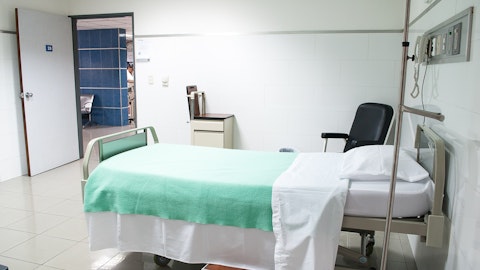Kemper Corporation (NYSE:KMPR) Q3 2023 Earnings Call Transcript October 30, 2023
Kemper Corporation misses on earnings expectations. Reported EPS is $-0.44 EPS, expectations were $-0.25.
Operator: Good afternoon, ladies and gentlemen. And welcome to Kemper’s Third Quarter 2023 Earnings Conference Call. My name is Leser and I will be your coordinator today. At this time, all participants are in a listen-only mode. Later, we will conduct a question-and-answer session and instructions will follow at that time. As a reminder, this conference call is being recorded for replay purposes. I would now like to introduce your host for today’s conference call, Karen Guerra, Kemper’s Vice President of Investor Relations. Ms. Guerra, you may begin.
Karen Guerra: Thank you, operator. Good afternoon, everyone, and welcome to Kemper’s discussion of our third quarter 2023 results. This afternoon, you’ll hear from Joe Lacher, Kemper’s President and Chief Executive Officer and Chairman; Brad Camden, Kemper’s Senior Vice President and Interim Chief Financial Officer; and Matt Hunton, Kemper’s Executive Vice President and President of Kemper Auto. We’ll make a few opening remarks to provide context around our third quarter results followed by a Q&A session. During the interactive portion of our call, our presenters will be joined by Duane Sanders, Kemper’s Executive Vice President and President of the P&C division, John Boschelli, Kemper’s Executive Vice President and Chief Investment Officer, and Chris Flint, Kemper’s Executive Vice President and President of Kemper Life.
After the markets closed today, we issued our earnings release and published our earnings presentation financial supplement and Form 10-Q. You can find these documents in the investor section of our website, Kemper.com. Our discussion today may contain forward-looking statements within the meaning of the Safe Harbor provisions of the Private Securities Litigation Reform Act of 1995. These statements include but are not limited to the company’s outlook and its future results of operations and financial conditions. Our actual future results and financial conditions may differ materially from these statements. For information on additional risks that may impact these forward-looking statements, please refer to our 2022 Form10-K and our third quarter earnings release.
This afternoon’s discussion also includes non-GAAP financial measures we believe are meaningful to investors. In our financial supplement, earnings presentation, and earnings release, we’ve defined and reconciled all non-GAAP financial measures to GAAP where required in accordance with the SEC rules. You can find each of these documents in the Investor Section of our website, Kemper.com. All comparative references will be to the corresponding 2022 period unless otherwise stated. I will now turn the call over to Joe.
Joe Lacher: Thank you, Karen. Good afternoon and thank you everybody for joining us today. We’re going to communicate several key points today, perhaps best grouped into four buckets. First is the favorable trend in our underlying results. Our underlying combined ratio improved sequentially and was inside the range of our prior guidance. Second is what’s happening outside the current year underlying results, including additional prior year reserve development. Third is the strong progress made on our strategic initiatives, which together reduce our long-term risk, improve our capital and liquidity, and enhance our ability to generate stable, long-term distributed cash flow in earnings. And lastly, we are reaffirming our full year 2024 guidance.
Let’s move to page 4. Looking at results, we’re pleased with the 1.5 point sequential improvement in the Specialty P&C underlying combined ratio as the benefits from our profit improvement actions take further hold. We have confidence in further improvements as we look forward. As expected, a 30 point California personal auto rate increase, effective in August, had only a marginal earned impact in the third quarter. Its earned impact will meaningfully increase in each of the next two quarters. This incremental earned rate, along with the additional benefits from all our other profit improvement actions, provides a significant tailwind for loss ratio improvement in the fourth quarter and more so for full year 2024. Moving to our second big topic, what’s happening outside of the current year’s underlying results.
Prior year reserve development was largely driven by recent trends in Florida Personal Injury protection or PIP, which has been an industry issue in recent quarters. And to a lesser extent, the extension of the Bodily Injury and Property Damage Development patterns from 2022. We’ll discuss the drivers further when we get to slide 6. Reflecting on our third major topic, we continue to make strong progress on our strategic initiatives. All our programs are on track to be completed on time and produce or exceed their targeted financial and operational benefits. Let me comment on a few highlights. We’re very pleased that our reciprocal exchange has received all necessary approvals and was actively writing business during the quarter albeit at expectedly modest premium levels.
The exit from the preferred home and auto business is moving as expected. This action will enhance our return on capital and support profitable growth in our core businesses. We expect to realize significant additional liquidity benefits in the fourth quarter from the Bermuda Optimization. And finally, we’re meeting or exceeding the expected expense savings with each of our cost structure initiatives. Advancing these initiatives further enhances Kemper’s operating capabilities and financial profile. We remain highly focused on returning the business to profitability and maximizing long-term shareholder value. This leads me to our last topic. We are reaffirming our 2024 financial guidance. We continue to expect a 2024 ROE equal to or greater than 10%.
I’ve spoken frequently about this environment being the most dynamic and volatile to personal auto insurance industry has ever seen. I still believe that. While, we believe this will persist for at least a year or two. We continue to be optimistic about what’s ahead for Kemper. And now I’ll turn the call over to Brad.
Brad Camden : Thank you, Joe. I’ll begin on page 5. As Joe highlighted, we had another quarter of improved underlying results, positioning us for return to profitability. Offsetting this progress is prior development, pension settlement, and catastrophes. For the quarter, we had a net loss of $2.28 per diluted share and adjusted consolidated net operating loss is $0.44. The net loss included a non-cash charge of $56 million related to the termination of our remaining pension obligations, which was previously recognized and accumulated other comprehensive income, or AOCI. The net loss and adjusted consolidated net operating loss included specialty auto adverse development of $78 million and catastrophes of $7 million. Last quarter, we announced that we were exiting the preferred P&C business, and as a result, the business is now reported below the line in non-core operations.

The business generated net loss of $7 million, including approximately $14 million in pretax catastrophe losses. Turning to the prior year reserve development details on page 6, Florida PIP Bodily Injury and Property Damage coverages drove reserve strengthening. PIP reserve changes resulted from increased frequency and severity of litigated claim activity, mainly from policy periods 2020 through 2022. Today, roughly three quarters of PIP claims have attorney representation up from two thirds a few years ago. We anticipate attorney representation for these policy periods will remain elevated and have reflected this in our reserving. On Bodily Injury and Property Damage related claims, we continue to see extended claim reporting timelines and more claims closing with payment.
This was mainly related to activity during the second half of 2022. As Joe noted, the environment continues to be volatile. However, given the short tail nature of our business, we are confident we have appropriately recognized these emerging trends in prior and current year reserves. Pages 7, 8, and 9 provide an update on our strategic initiatives. These are on track to be completed on time, producing or exceeding their targeted financial and operational benefits. As we launched the Bermuda project in 2022 and we continue to optimize the initiative. We expect $250 million in life dividends to be paid to the parent in the fourth quarter, up from $200 million as previously indicated. This continues to create value and financial flexibility for the company.
This quarter, we also included our multiyear pension termination project, which reduced our tail risk and related expenses. We recognized a $56 million non-cash charge to finalize the termination, which was previously recognized in AOCI and is therefore neutral to shareholder’s equity. Last quarter, we announced our exit from the preferred P&C business. The winddown process is underway and is expected to release approximately $175 million of capital by the end of 2024 and another $100 million in 2025. Next, our cost reduction initiatives are on track to produce their intended benefit. Since the onset of this effort, we have already achieved over $135 million of run rate savings. which is roughly 90% of our goal previously projected to be realized by 2025.
And finally on page 9, the Kemper Reciprocal Exchange was established and began writing policies in Illinois in the third quarter. Over the next year, we plan to populate the exchange by reinsuring select new business from Kemper legal entities and directly writing premium in the exchange. Growth is expected to ramp up as we receive approval to expand into new states. We plan to host a special topic called during the first quarter of 2024 to disclose the reciprocal structural and financial reporting. Moving to page 10, our insurance companies are well capitalized and have significant resources of liquidity. At the end of the quarter, we had $820 million of liquidity consisting of revolver developer capacity, inner company lending capacity, and holding company cash and investments.
We expect parent liquidity to be bolstered by at least $250 million in the fourth quarter from our Bermuda Optimization. Our healthy liquidity balance enabled us to support our operating subsidiaries and pay holding company dividends and interest payments. We continue to have the capital and liquidity needed to navigate this ongoing dynamic operating environment. Moving to page 11, net investment income for the quarter was $107 million and our pretax equivalent annualized book yield was 4.6%. Lastly, our approach to asset liability management continues to produce the intended results in a rising interest rate environment. I will now turn the call over to Matt to discuss the Specialty P&C business.
Matt Hunton : Thank you, Brad, and good afternoon, everyone. Moving to page 12 in our Specialty P&C business, we closed the third quarter with an underlying combined ratio improvement of 1.5 points sequentially and 6.3 points year-over-year. This was a result of incremental earned rates and ongoing underwriting actions, including new business restrictions, which was partially offset by severity and seasonality. And while loss trends remain elevated, they have stabilized. Earned rate increases forecast, and we expected to accelerate in the fourth quarter and in 2024 due in part to the 30 points of California rate effective in August of this year. We anticipate the cumulative benefit of our profit actions to continue to exceed loss trends.
We are observing hard market conditions, especially in California. As we renewed policies at higher rates, persistency remained in line with prior periods, creating favorable premium retention. This quarter, we filed an additional six points of rate on 13% of the book. Going forward, we will make rate and segmentation filings across the business as needed. This quarter, Specialty P&C observed a moderate level of catastrophe losses driven by tropical storms and wind/hail events. Our commercial vehicle underwriting and rate actions are continuing to positively impact loss performance. In the third quarter, the underlying combined ratio was 93.6%, and we project continued profitability as pricing remained strong. As mentioned on the second quarter call, we are planning to selectively write a modest amount of incremental new business to test new customer cohort buying and claim behavior.
Moving to page 13, we remain hyper focused on achieving target returns as cumulative actions will continue to outpace loss trends. In addition, enhanced tools and analytics will enable a thoughtful balancing of underwriting profitability and new business writings. Finally, despite the ongoing dynamic environment, we anticipate achieving target profitability in 2024. I will now turn the call over to Joe to cover the life business.
Joe Lacher: Thank you, Matt. Turning to page 14, net operating income for our Life business was $15 million for the third quarter. Profitability improved over the prior year quarter and sequential quarter. Consumer demand for our products is strong, with life issue policies were up slightly and persistency remains stable. Life business continues to generate strong returns on capital and distributed cash flow. Turning to page 15, to reiterate our highlights for the quarter. One, we made solid progress on improving underlying combined and loss ratios. The California rate change for specialty auto, while an increasing impact over the next two quarters, reinforcing our confidence in returning to target margins. Two, our strategic initiatives are on schedule and expected to meet or exceed all financial targets.
And three, we are reaffirming our 2024 financial guidance of delivering an ROE of 10% or greater. In closing, I’d like to thank our entire Kemper team for their ongoing dedication and commitment to executing on our strategic priorities to generate consistent, long-term shareholder value. Operator, I’ll turn it over to you for questions.
See also 25 Least Forested Countries in Europe and 25 Least Racist States in the US.
Q&A Session
Follow Kemper Corp (NYSE:KMPR)
Follow Kemper Corp (NYSE:KMPR)
Operator: Your first question comes from Greg Peters from Raymond James.
Greg Peters: Well, good afternoon, everyone. I guess I’ll start, I have a couple of questions and I’ll start first with the top line and the policy count in your specialty book. It’s declining substantially on a year-over-year basis and sequentially. Can you talk about how, as you deploy, the rate increases, how your rate might be competitively disadvantaged or other factors that might be contributing to the drop off in policy count and written premium?
Joe Lacher: Sure, Greg. This is Joe. I’ll take a start at it. And Matt, you can jump in with more thoughts. This is largely driven, Greg, by our reduction in new business or our constraint on new business policies. Our retention rates are consistent and or even up slightly from where they were pre-pandemic levels. So this is driven by the new business curtailment. We will likely restart and start to reintegrate some of that new business, as Matt mentioned in the fourth quarter and into the first. We’ll start slowly and test the system, if you will, and let another quarter of rate earn in and watch the underlying loss ratios improve. But this is largely driven with what we’re seeing on our new business underwriting criteria, constrained business, rather than what we’re seeing as a competitive problem that’s driving lapse rates up.
Matt Hunton : Just a quick add on to that. So as non-standard specialty customers churn at a bit of a higher rate. So naturally, as you don’t put on new business, you’re going to see policies enforce leak a little bit more. Just a quick comment on the rate and its stickiness. We are seeing policy persistency actually slightly elevated versus prior periods. So our renewal book, as it’s converting at higher win and earn rate levels, is sticking at a higher rate. But as Joe mentioned, the drawdown in policies in force is really a function of the lack of new business that we have coming in at this point, and we’ll balance that as we move forward over the next couple of months.
Greg Peters: Okay. Thanks for providing that color. Just on, you did mention in your answer and your prepared remarks, this desire to start growing certain cells or test the system. I’m just curious how that’s going to look because kind of with your combined ratios, reported combined ratios where you are that probably want the margin to improve before you start writing a bunch of new business, but provide some additional perspective on that, Joe.
Joe Lacher: Sure. Greg, we’re — we did not say we were going to grow a bunch, and we did not say we were going to add a bunch of new business. Those were not remotely close to the words we said. We were going to start to write some modest amounts of incremental new business. We’ve got a very significant new business slowdown. If you were thinking about sort of a 2019 level, it’s way off of that. We’re going to modestly add some new business at some point, probably in the fourth quarter or the first quarter to test how the underwriting criteria as we take them off, what comes in to the book of business, how that business is performing in its early stages, how those underwriting filters work. One of the things we’ve talked about before is when you have a market and a consistent view of carriers and underwriting appetites, you know how things are going to work.
As the market hardens and you find people put up different underwriting restrictions or different price points, business will move around the marketplace differently. But what we want to do is open the filters a little bit and we believe we know what will happen when we do that and we’re going to test it. And so we’re going to watch it every day, every week, every couple of weeks and see what’s coming through in that process and did what come through, did what actually come through their behave and look like from a profile perspective and a performance perspective, what we expected. And again, I’ve used this analogy. If you’ve got a little bit of the stomach flu, you don’t go back and eat everything you did the week before, you start out with a brat diet of the bananas, rice, applesauce and toast and reprimand the system.




